
This is a wonderful site with a lot of information, and some unusual things as well, worth a look, from ancient travelers to the America's
to small artifacts found in South America that resemble Air planes, and more. Thought I would share what this team has put together
to help us understand they many mysteries, and possibilities, and added questions about the ancient pasts of the America's.
(This is just a taste of what this site has to offer the searchers of history, click on "Pre-Columbian America" above to go to the full site.)
| Featured Pre-Columbian Locations: |
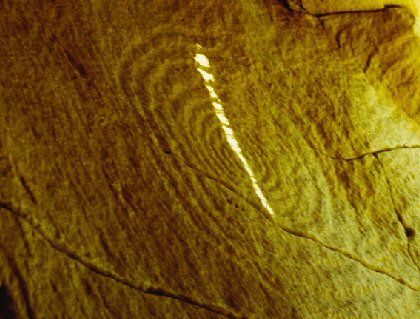 The Chaco canyon 'Sun-dagger' The Chaco canyon 'Sun-dagger'In what is now the state of New Mexico in an area known as Chaco Canyon are the remains of an elaborate development of the Anasazi people who lived in the region from about 500 to 1300 AD. Some 120 meters (400 feet) above the canyon floor near the top of an outcropping known as Fajada Butte, three slabs of sandstone were placed against a rock wall creating a shaded space. Carved into this shaded wall are two spiral petroglyphs, one large and one small. Sunlight passes over them at various times throughout the year as it streams through chinks between the sandstone, but it was not until the 1970s that their true purpose was literally illumined.
The stepped pyramid-temple (Right), records the equinoxes in a unique way. The sun creates a shadow of a huge 'snake' to ascend the steps in spring, and descend again in autumn (2). Whether or not this was a deliberate design feature is speculative, but other astronomical features at the site certainly lend weight to the idea that it was intentional. Each step corresponds to a day, each platform to a Mayan month. The temple is erected above the 365 steps. (17)
Machu Pichu - (Mountain Citadel) 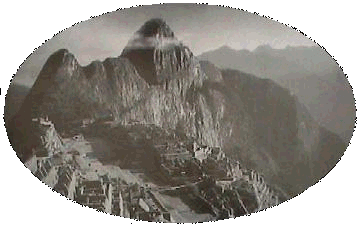 This Pre-Columbian Inca mountain citadel was only rediscovered in 1911. It shows several strong indications of astronomical observation. The structures are built from white granite, with blocks reaching up to 3.7 metres in length. This Pre-Columbian Inca mountain citadel was only rediscovered in 1911. It shows several strong indications of astronomical observation. The structures are built from white granite, with blocks reaching up to 3.7 metres in length. Location of the famous Intihuatana stone, also called "The Hitching Point of the Sun" because it was believed to hold the sun in its place along its annual path in the sky. At midday on March 21 and September 21, the equinoxes, the sun stands almost above the pillar—casting no shadow at all. Skeletal remains show a 10:1 ratio of females to males. (12)
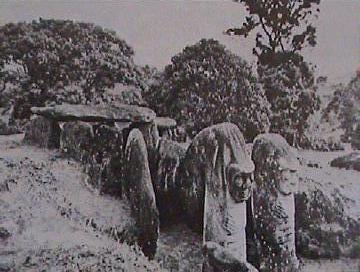 San Agustin, Columbia: (Megaliths and Hypogea). San Agustin, Columbia: (Megaliths and Hypogea).The San Agustin archaeological park in Colombia includes a wide variety of stone sculptures (Megaliths), mostly carved between AD 100 and 1200. In the park are an amazing array of separate stone sculptures, in the shapes of animals and warriors and human faces, some mythical, some realistic. They are carved out of volcanic rock - some are over 4 meters tall and weigh several tons. The site, excavated by K. Th. Preuss during the 1940s, has been declared a World Heritage Site.
It was suspected by Stansbury Hagar, that the city had been built as a 'map of heaven'. During the 1960's and 1970's a comprehensive mathematical survey was carried out by Hugh Harleston Jr who determined that the principle structures line up along the street of the dead (and beyond), and that the city was a precise scale model of the solar system. (21) The Pyramid of the sun (Right), has the same base dimensions and half the height of the great pyramid in Egypt. |
The Copper 'Reels'
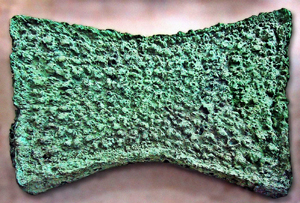
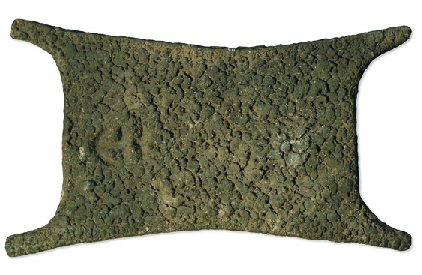
Copper ingot from Crete (Left), and a British Museum Ingot from the 'Foundry Hoard' at Enkomi, Cyprus c. 1225-1150 BC (Right).American sites have yielded considerable numbers of copper tablets shaped like the hide of an animal; and they were named 'reels'. In 1896, in Cyprus, and subsequently in many Mediterranean excavations, corresponding 'Bronze Age' copper objects, recognised now as ingots used in international currency, have been found. The American examples indicate an international trading system existed. (1)
| The Mound Builders. |
USA has more than 100,000 artificial mounds between the great lakes and the Gulf of Mexico. (12)
(More on this subject soon)
| The Olmecs: An African Presence? |
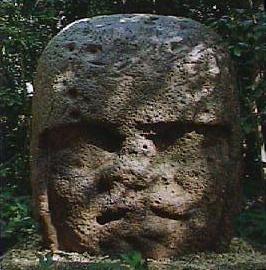
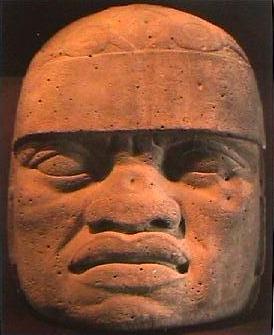
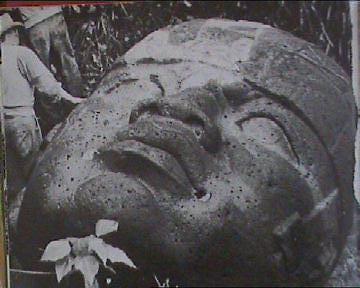
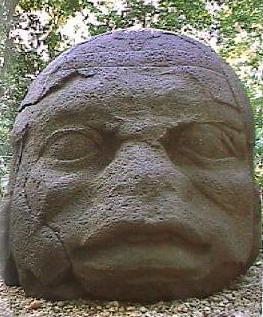
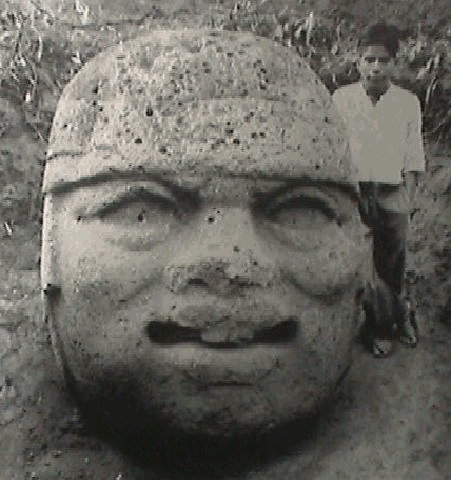
There have been several previous attempts to prove the 'fusion' of African and native Pre-Columbian American races. Evidence has been put forward ranging from linguistics, plant geography, skeletons, terracotta figures and even North African 'Tifinag' inscriptions on the Virgin Islands. (3) However, nowhere is the evidence for this argument stronger than at La-Venta and San Lorenzo, where several large stone heads and have been discovered that clearly display Negroid features.
 The huge proportions of the heads demonstrates that they were influential people, and their association with the Olmec culture at around (1,200-600 B.C.) places them long before the Maya, Inca or Columbus's arrival in America. Van Sertima concluded that these people originated from Egypt and the middle-east.
The huge proportions of the heads demonstrates that they were influential people, and their association with the Olmec culture at around (1,200-600 B.C.) places them long before the Maya, Inca or Columbus's arrival in America. Van Sertima concluded that these people originated from Egypt and the middle-east. '...unique amongst aboriginal American sculptures, it is remarkable for its realistic treatment. The features are bold and it is amazingly negroid in character'.
The head was found 10 miles from the source of the stone and a long slab of stone which was found at the same site yielded a precise date of Nov 4th. 291 BC. As digging increased in south America other larger heads and earlier heads were found at sites such as La Venta, which began to reveal a chapter of history in the pre-Columbian Gulf of Mexico that was almost lost to us. The La Venta heads showed several similarities to the Tres Zapotes heads, and it emerged that they dominated the ceremonial plaza, a feature which suggests that they were in some way 'revered'. Four heads were found at La Venta, all of them faced the Atlantic, and the largest at 9ft high had its domed top flattened so that it could function as an altar. A speaking tube was found going in at the ear and out at the mouth; a possible oracle or talking god. Radio carbon dates from the site were published in 1957 and they give an average reading of 814 BC +/- 134 yrs. These figures were among the oldest at the La Venta site.
La Venta was not alone in its depiction of Negroid faces in stone. Apart from the four found there, two were excavated in Tres Zapotes and a further ten at San Lorenzo in Vera Cruz, one of which, the largest known, is nine feet, four inches high, and is estimated to weigh around 40 tons (3). The theory forwarded by Van Sertima reinforcing the theory that the 'Olmec' sites of La Venta and Tres Zapotes were governed by Negroid Africans and Middle-eastern Caucasians between 800-600 BC,
In 1972, craniologist Andrzej Wiercinski reported that 13.5% of the 76 fragmentary crania from Tlatilco, a site associated with the Olmec civilization, showed "a clear prevalence of the total Negroid pattern" (Jordan 1992). Wiercinski measured the skulls for 48 morphological traits, but focused on the traits he considered best for discriminating between the "three great races of man" (Van Rossum 2004). The remains were dated to the Pre-Classic Period (1,500 BCE-300 CE), well before the arrival of Columbus. (3)
| An Australian presence in Pre-Columbian America: |
A Genetic link has been determined between the Aborigines of Australia and the 'Fuegian's' from 'Tierra-Del-Fuego' in Southern-most America. This suggests a connection at least 30,000 years old.
Article: BBC. Science News. (August, 1999)
'The first Americans were descended from Australian aborigines, according to evidence in a new BBC documentary. The programme, Ancient Voices, shows that the dimensions of prehistoric skulls found in Brazil match those of the aboriginal peoples of Australia and Melanesia. Other evidence suggests that these first Americans were later massacred by invaders from Asia'.
There is a physical similarity between the 'La-Jollans' of Southern California, who also used the spear thrower, had initiation ceremonies for boys, women excluded, the twirling of a 'Bull-roarer', and with ground paintings involved. La Jollan artefacts are virtually indistinguishable from those of the Kartan culture of Australia. (3)
| The Pre-Columbian Pyramid Builders: |
In 1964, aerial photography identified nearly 1,000 pyramid sites in Peru alone.
(4) The existence of pyramids in the Americas has often been suggested as a significant proof of contact between people from the 'Old' and 'New' worlds. However, this claim has been reasonably contended with the argument that the similarity in shape proves no such thing, and that such claims can only be validated by providing through substantiating proof, such as cultural, botanical and more recently, genetic research.
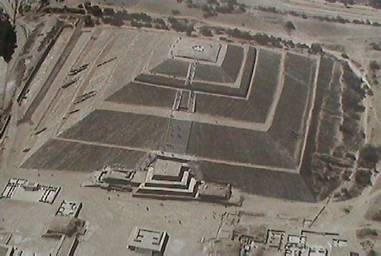

Whether through accident or design, it is a fact that the 'Pyramid of the Sun' at Teotihuacan has the same base dimensions and is half the height of the 'Great' pyramid at Ghiza.
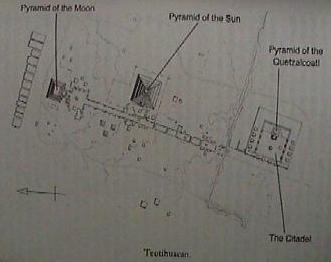
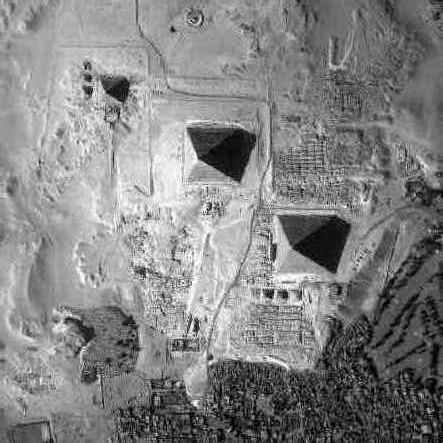
The layout of the two great pyramid complexes have also been compared.
Pyramids and the Feathered Serpent.
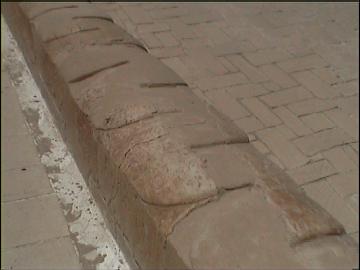

The Great stairwell at Hatshepsut's Mortuary temple includes a huge feathered serpent running down each side of the stairwell.
The feathered serpent is a very specific and fundamentally important symbol of both South American and Egyptian cultures. In Egypt during the Middle kingdom, the symbol can be generally interpreted as representing a united Egypt (both upper and lower). In South America, the symbol was used to represented the god Quetalcoatl.
Further similarities become apparent when we look at the similarities of 'function' between pyramids from the two cultures. We know for example that there was an astronomical association in both cultures. Van Sertima notes that 'When pyramids appear in America in the Olmec culture they are orientated astronomically'. (3) Of course, the fact that the Babylonian ziggurats and Egyptian pyramid were also built by 'Solar' worshippers is just one of the many other cross-cultural similarities that can be seen.
Palenque.
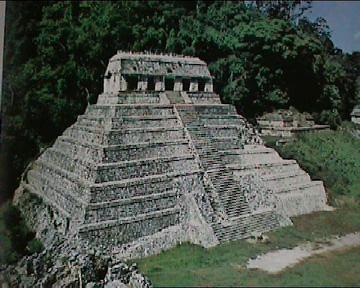
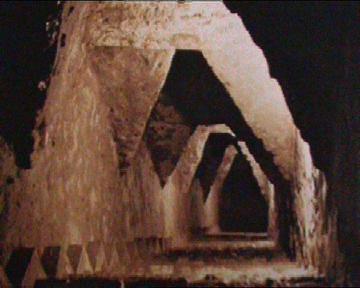
The Mayan pyramid of Palenque, within which the tomb of King Pakal was discovered in 1952.
We know without question that the Egyptian pyramids came first, and by a few thousands years, so there is no suggestion of contact between the pyramid builders themselves. However, it is undeniable that the theme of pyramid building was a global phenomena which occurred around the world, and not just in Egypt. In fact, it is also seen in the middle east, the far east, on the Pacific Isles, in the Americas, and even in Europe.
| Indian Maize (Corn)...? 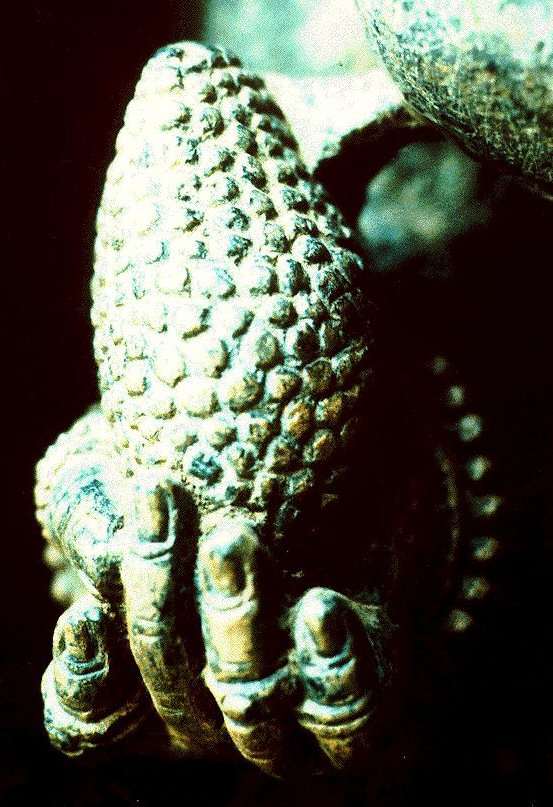 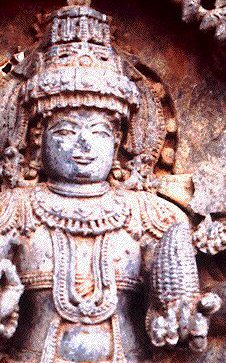 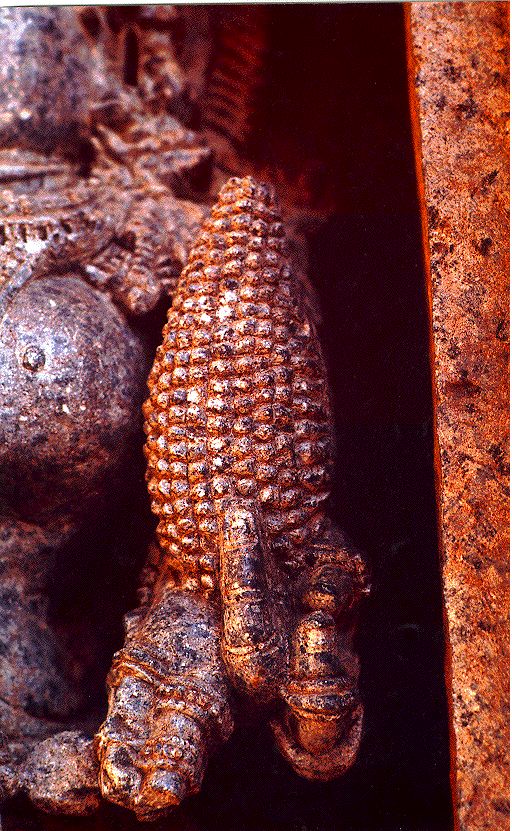
|
| The Piri Reis Map: |
The significance of this map is sometimes overshadowed by the various myths and claims surrounding it. Regardless of the debatable claim that the map shows the outline of the Antarctic continent, there are certain demonstrable facts which make this map potentially one of America's most valuable historical relics.
The Piri-reis map (c. 1513), is a fragment of a larger composite map of the world, with its epicentre in Egypt. It was created with a working understanding of longitude and latitude and a system of geometry which allowed the cartographer to accurately draw the outlines of Africa and America relative to each other.The legend on the map dates it to 'Muharran' in the Muslim year 919 (1513 AD), only 20 years after the official discovery of the Americas by Columbus in 1492. The legend itself however, gave claims an origin far older than 20 years, revealing that it was a section of a world map composed from more than twenty source maps, some drawn in the time of Alexander the great, and that 'some were based on mathematics' (7).
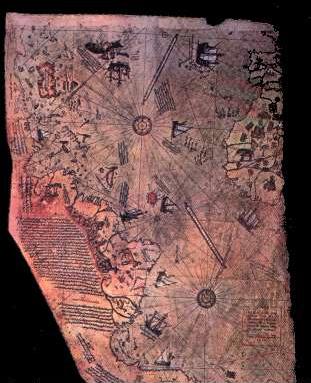 The map has pre-Columbian provenance.
The map has pre-Columbian provenance.
The map shows the eastern coastline of America.
The map shows accurate use of Longitude and Latitude.
The map-builders used 'Spherical geometry'.
The centre of the map is at the junction of the 23.5˚ parallel and the longitude of Alexandria.
The cartographers of the Piri-reis map used a system called the 12-wind system, which was used extensively in the middle ages and has its roots in the Babylonian sciences.
| The Mystery of the Cocaine Mummies: |
In 1976 a German scientist, Dr Svetla Balabanova, made a discovery which was to baffle Egyptologists, and call into question whole areas of science and archeology to chemistry and botany.
She discovered that the body of Henut Taui contained large quantities of cocaine and nicotine. The surprise was not just that the ancient Egyptians had taken drugs, but that these drugs come from tobacco and coca, plants completly unknown outside the Americas, unheard of until Sir Walter Raleigh introduced smoking from the New World, or until cocaine was imported in the Victorian era.
Following this discovery, other experts began testing Mummies and discovered Tobacco for example the substance was found in Mummies from the British Musuem by their keeper Dr.Rosalie David. There was even some found on the bandages of the great Rameses II himself by Dr. Michele Lescaux!
Article from the official Ancient Egyptian Bibliography (AEB) published by the University of Leiden.
NERLICH, Andreas G., Franz PARSCHE, Irmgard WIEST, Peter SCHRAMEL and Udo LÖHRS, Extensive pulmonary haemorrhage in an Egyptian mummy, Virchows Archiv. An International Journal of Pathology, Berlin - Heidelberg 427 (1995), 423-429. (ill.).
Report on the morphological and trace element findings of several internal organs from an Egyptian mummy approximately dating from the year 950 B.C. according to C-14-analysis. By use of a multidisciplinary approach the authors succeeded in discovering evidence for severe and presumably recurrent pulmonary bleeding during life. This was suggested by the finding of massive haemosiderin deposits in the lung and a selectively and markedly elevated level of iron in trace element analysis of the lung tissue. Furthermore, an enhanced deposition of birefringent particles in the lung tissue, without significant fibrosis, was observed. The histological analysis of liver, stomach and intestine confirmed the macroscopic organ diagnoses without evidence of any major pathological processes. In addition, analysis for various drugs revealed a significant deposition of tetrahydrocannabinol (THC), nicotine and cocaine in several organs of the mummy. The concentration profiles additionally provide evidence for a preferential inhalation of THC, while nicotine and cocaine containing drugs seem to have been consumed orally.
Report on the morphological and trace element findings of several internal organs from an Egyptian mummy approximately dating from the year 950 B.C. according to C-14-analysis. By use of a multidisciplinary approach the authors succeeded in discovering evidence for severe and presumably recurrent pulmonary bleeding during life. This was suggested by the finding of massive haemosiderin deposits in the lung and a selectively and markedly elevated level of iron in trace element analysis of the lung tissue. Furthermore, an enhanced deposition of birefringent particles in the lung tissue, without significant fibrosis, was observed. The histological analysis of liver, stomach and intestine confirmed the macroscopic organ diagnoses without evidence of any major pathological processes. In addition, analysis for various drugs revealed a significant deposition of tetrahydrocannabinol (THC), nicotine and cocaine in several organs of the mummy. The concentration profiles additionally provide evidence for a preferential inhalation of THC, while nicotine and cocaine containing drugs seem to have been consumed orally.
- Hand-Shaped Incense Spoons. - Van Sertima mentions the presence of similar 'Hand shaped incense spoons' in both 'Old-world' and 'New-world' cultures.
The following two photos (below left and right), from Denderra, Egypt, are perhaps what Van Sertima (3) is alluding to... although, and I daresay its all in the eye of the beholder .. but it looks as though the contents of these '
incense burners' are being inhaled. 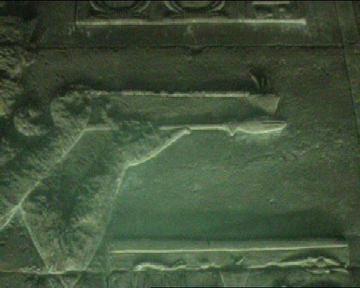
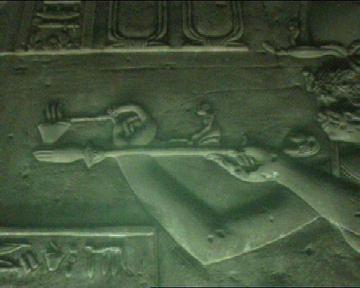
'Burnt Offering's' at Denderra, Egypt.
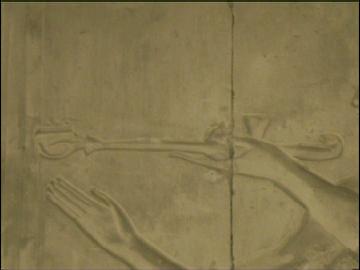
More 'burnt offering' from Abydoss.
| The Model Aircraft: |
It is perhaps just another one of life's curious coincidences that these small aerodynamically sound 'models' have been found in both South America and Egypt. Whatever the kismet, they provide good food for thought.


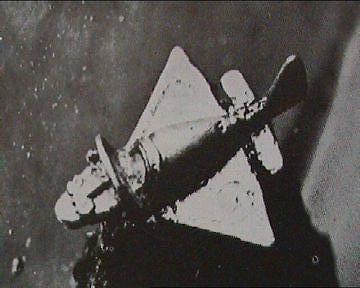
Egyptian '
model' (left), S. American 'models' (centre, right). 
This particular 'model' is on display in the Smithsonian Institute in Washington DC. Its explanation states: “gold artefact, a stylised insect, from the Quimbaya culture, Antioquia province, Columbia, ca. 1000-1500 AD.”

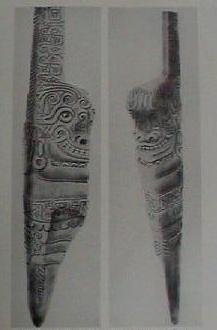
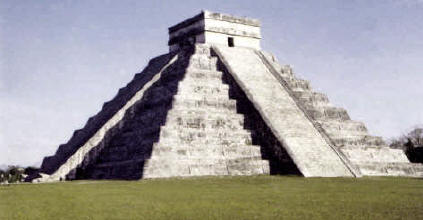
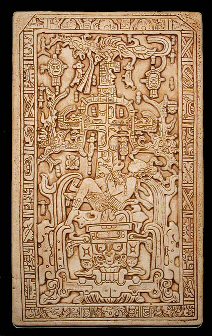
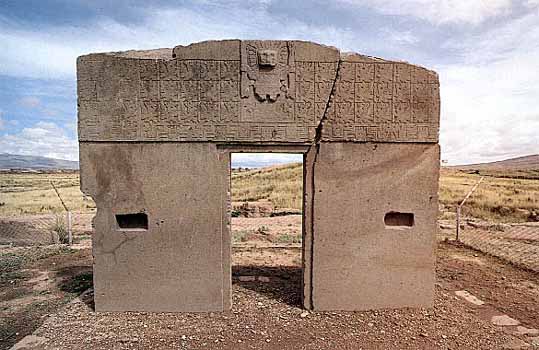
No comments:
Post a Comment